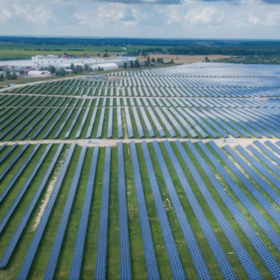The Budget announcement on issuing sovereign green bonds will support the growth in India’s renewable energy sector, which already continues to outpace all other global economies, says a report by the Institute for Energy Economics and Financial Analysis (IEEFA).
Green bonds are among the most widely used instruments for funding green infrastructure. The union budget 2022 unveiled by India’s finance minister includes a plan for issuing sovereign green bonds for projects that will assist in reducing the carbon intensity of the economy.
Sovereign green bonds have been issued by several countries in the recent past such as France, Germany, the UK and Indonesia, among several other nations, and will prove to be an essential source of capital for emerging countries to fund their energy transition journey.
Report co-author IEEFA’s Shantanu Srivastava says the sovereign issuance will assist green energy companies in India gain access to cost effective financing.
“While no other details have been shared regarding the issuance size and allocation for specific industries and technologies, this is a welcome move,” says Srivastava. “And it in fact echoes what has already been happening. Several industry players have raised capital through the green bond route in the past.”
Journey so far
IEEFA’s new report finds India’s renewable energy financing market has transformed massively over the past decade to include a plethora of different players vying for a piece of the growing sector.
“This environment fosters opportunities, especially in solar, that investors have yet to tap,” says report co-author, infrastructure finance specialist Ankur Saboo.
The report notes that in January 2010, the National Solar Mission (NSM) was launched with an initial target of 20 GW of installed solar power by 2022 but the target, revised twice, now stands at 100GW of solar PV to be installed by the end of this year.
The growth has been supported by an equally large amount of domestic and global capital, as both debt and equity, invested in Indian renewable energy infrastructure. Debt, the main fodder for renewable energy projects, has come through various channels as the industry matured and as financiers from all quarters gained a better understanding of its risk return dynamics, stated the report.
Private non-banking financial companies (NBFCs) were the first entities to test the waters by lending to renewable projects, when capital from other conventional sources such as banks found it best to avoid exposure to a nascent and evolving technology.
Financing has transformed significantly since then as sources expanded. Banks (private and public), the bond market (domestic and global), international lenders, development finance institutions (DFIs) and other sources of debt now compete for a piece of the growing renewable energy sector. Private NBFCs, the flag bearers at the start of the journey, have been overshadowed by larger banks, completely changing the renewable energy finance landscape.
Mutual funds entered the market through the domestic bond route soon after the banknote demonetisation undertaken by the Government of India in 2016, helping renewable energy companies by providing lower rates, increasing lender competition, adding a new avenue for funding operating projects and helping companies reduce exposures with certain lenders where exposure norms were hit.
“The biggest boon for the renewable energy sector has been access to global bond markets,” says Srivastava.
“The international bond market has demonstrated immense depth, proactiveness and boldness towards the sector, thanks to global understanding, high yield offerings and the initial success and pedigree of large players.
Opportunities galore
“With sovereign green bonds in the mix now, several global investors will be interested in taking exposure to the Indian market, given the instruments’ sovereign ratings,” says Srivastava.
“With increasing complexity and project sizes, the meaningful presence of these different players bodes well for continued growth of the sector. For a capital-intensive area, a highly competitive funding landscape is arguably the biggest growth driver,” adds Saboo.
In India’s journey from 100 GW to 500 GW of renewables, “critical factors for sustained financing include lenders adapting to the evolving renewable market, tapping environment focused investors, building a dedicated infrastructure finance bank in India and careful evaluation and financial structuring of the technological shift towards Indian modules and inverters, states the report.
The report states lenders must continuously research the evolving renewable market. On a more immediate basis, there are still untapped opportunities in green field projects, hybrid, storage and round-the-clock bids, and household plus commercial and industrial (C&I) rooftop solar projects.
This content is protected by copyright and may not be reused. If you want to cooperate with us and would like to reuse some of our content, please contact: editors@pv-magazine.com.









By submitting this form you agree to pv magazine using your data for the purposes of publishing your comment.
Your personal data will only be disclosed or otherwise transmitted to third parties for the purposes of spam filtering or if this is necessary for technical maintenance of the website. Any other transfer to third parties will not take place unless this is justified on the basis of applicable data protection regulations or if pv magazine is legally obliged to do so.
You may revoke this consent at any time with effect for the future, in which case your personal data will be deleted immediately. Otherwise, your data will be deleted if pv magazine has processed your request or the purpose of data storage is fulfilled.
Further information on data privacy can be found in our Data Protection Policy.